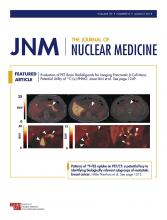Since the first clinical use of 131I-labeled prostate-specific membrane antigen (PSMA) (1), xerostomia has been identified as a relevant side effect of PSMA radioligand therapies (PRLTs) for metastatic castration-resistant prostate cancer. Given the remarkable progress when using 177Lu-labeled compounds and the impressive results of 225Ac-PSMA PRLT (2), we believe that effective preventive strategies for salivary gland (SG) toxicity need to be developed to preserve the extremely attractive side effect profile of PRLT (3) as compared with standard treatments. Although the highest off-target uptake is seen in the SG (3), multicenter data on 177Lu-PSMA PRLT revealed only mild to moderate reversible xerostomia in 8% of patients (4). In a systematic analysis, our group confirmed these findings (5).
The largest available data on 225Ac-PSMA were published by Kratochwil et al. (2). In the Heidelberg cohort, severe xerostomia occurred frequently and became the dose-limiting toxicity. Among the 40 patients, treatment had to be discontinued in 4 patients despite an initial response. Our group’s first clinical results in 6 patients treated with 225Ac-PSMA were in line with those findings. After a first treatment cycle, 1 of 3 patients with sufficient follow-up data had experienced (tolerable) mouth dryness, whereas another patient treated with 5 MBq of 225Ac-PSMA (83 kBq/kg of body weight) had subsequent markedly decreased uptake in all SGs (Fig. 1).
Physiologic tracer uptake is detected in SGs of 59-y-old metastatic castration-resistant prostate cancer patient on pretherapeutic 68Ga PET/CT study (A), whereas PSMA uptake in SGs declines by up to 65% on follow-up imaging (B and C) after PRLT using 225Ac. Dynamic SG scintigraphy demonstrates regular baseline function (D); however, posttherapeutic study reveals functional impairment despite absence of clinical symptoms of xerostomia (E).
With respect to the potential survival benefit of PSMA-directed radionuclide therapies, we believe that severe reduction in quality of life will gain more significance in the future. Recently, Taïeb et al. focused on SG toxicity from PRLT and discussed several approaches (6), including a reference to xerostomia after external-beam radiotherapy of patients with head and neck cancer. Although the exact molecular principles of tracer accumulation, in particular the ratio of nonspecific over specific uptake in SGs, are still insufficiently understood, PRLT, unlike external-beam radiotherapy, offers potential routes to prevent radiation exposure to SG tissue by avoiding or reducing radionuclide uptake. In multicycle therapy, declining tumor volume—and thus target PSMA binding—increases off-target uptake (7), greatly burdening the dose-limiting SGs. Reduction of administered activity to limit xerostomia hence comes at the expense of tumor dose, especially in responding patients.
Alternatively, labeling of PSMA-targeting antibodies such as J591 instead of small molecules such as PSMA-617 might be able to lower the sialotoxicity of 225Ac-PSMA PRLT because there is no significant SG uptake on 89Zr-J591 or 177Lu-J591 imaging (8,9). This effect unfortunately comes at the cost of increased myelotoxicity due to longer blood circulation. The difference in molecular weight between PSMA-targeting antibodies and small molecules (∼150 vs. 1.4 kD) could explain some of the variation in SG uptake. Along these lines, the ionic charge of PSMA radioligands might also play a role in SG distribution, though changing molecular electronegativity risks an impact on tumor affinity.
External cooling of the SGs using icepacks was initially expected to reduce PSMA radioligand uptake due to vasoconstriction but failed to prove helpful in a systemic analysis (10). Considering the intense blood supply of organs near the head, insufficiency might be explained by a reflex hyperperfusion.
Preclinical animal data on potential radioprotective substances injected into the SGs, such as botulinum toxin A, short-acting anticholinergic agents, and local anesthetics, appear promising (11). Other radioprotectors have also been tested, such as histamine, vitamin E, statins, and amifostine, exploiting mechanisms of radiation resistance. In humans, Teymoortash et al. investigated the effect of botulinum toxin injections to the SGs with head and neck cancer undergoing external-beam radiotherapy (12). Earlier this year, our group translated that approach into tracer uptake blockade and achieved a 64% decrease in 68Ga-PSMA uptake in an injected parotid gland, leading to the first proof-of-concept publication on the topic (13) and heralding a hypothesis of nonspecific tracer accumulation. Given the possibility of some specific binding of PSMA radioligands in the SGs, local application of cold compounds or inhibitors of PSMA such as 2-(phosphonomethyl)pentanedioic acid (14) are also being investigated. However, the potential inhibition of PSMA-targeted tumor caused by systemic absorption from intraparenchymal application of 2-(phosphonomethyl)pentanedioic acid (because of the relevant blood supply, especially of the parotid glands) warrants careful consideration.
Sialendoscopy data on thyroid cancer patients with radioiodine-induced sialadenitis suggest another outlook. Therapy-refractory xerostomia could be explained by duct stenosis and mucous plugs in 86% of occurrences; sialendoscopy intervention resulted in 89% of patients with partial or complete resolution of symptoms (15). Of note, time does matter, because better results were obtained for earlier endoscopic treatment than for intervention for chronic symptoms (16).
Another salvage approach might be regeneration of the SGs. In a clinical trial of head and neck cancer patients after radiotherapy, ultrasound-guided transplantation of adipose tissue–derived mesenchymal stem cells to the submandibular glands for treatment of radiation-induced xerostomia achieved an increase in salivary flow of 33% after 1 mo and 50% after 4 mo (17).
The reasons why SGs take a bigger hit than most of the other exposed organs could lie in the biology of the glands themselves. A high propensity to trigger apoptosis and the myriad of secretory granules that potentiate formation of radiation-induced free radicals are promising hypotheses (18). Perhaps current radiopharmaceuticals hit the SG sweet spot of low-dose hyperradiosensitivity. Whether by optimized doses, compounds with better biodistribution, new radioprotectors, blockers of PSMA binding, better posttherapy management, or cellular transplantation, PRLT requires us to solve the SG enigma.
DISCLOSURE
No potential conflict of interest relevant to this article was reported.
Footnotes
Published online Jun. 14, 2018.
- © 2018 by the Society of Nuclear Medicine and Molecular Imaging.
REFERENCES
- Received for publication May 8, 2018.
- Accepted for publication June 7, 2018.








